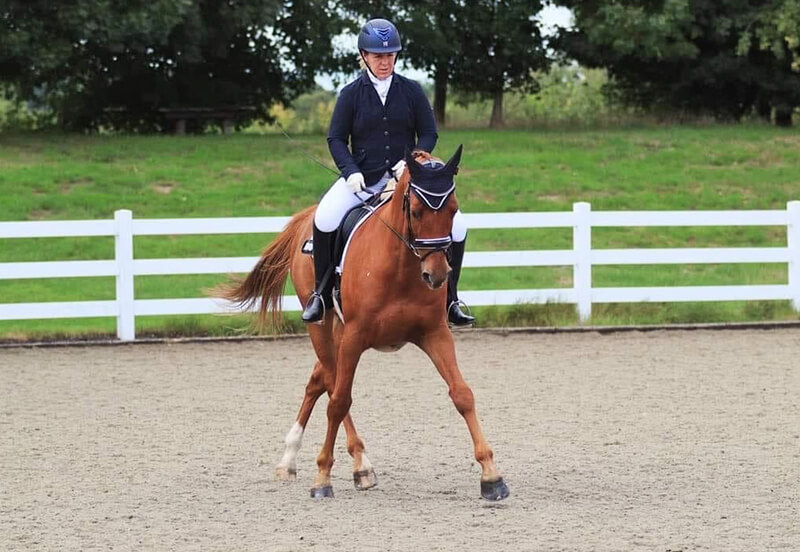
Leg-yield is one of the first lateral movements horses are taught. And it is a movement that remains useful from novice horses to advanced horses. It teaches a horse to move away from your leg and move through their body, and useful to introduce young horses to the outside rein by teaching them to push off the inside leg aid into it.
What is a leg-yield?
Leg-yield is a lateral movement in which a horse travels both forward and sideways at the same time, keeping in the correct two beat movement in diagonal pairs. When performing a leg-yield the horse must have the shoulder leading and remain fairly straight through his body, with a slight bend opposite to the direction of travel.
Although leg-yields are only a movement in an Elementary dressage test, it is used regularly in the warmup by higher-level riders as it introduces suppleness and prepares the horse for higher level movements, such as halfpass.
How to perform leg-yield?
The aids in the leg-yield require communication between the inside aids and the outside aids. The inside leg asks the horse to yield to the side away from the leg, while the outside leg asks the horse to continue forward, maintaining straightness and keeping the rhythm. The inside rein asks for slight flexion in the opposite direction of travel while the outside rein helps maintain straightness and tempo, while keeping the shoulder up and not allowing the horse to drop the shoulder and run through the rein.
The rider’s position should be balanced with the shoulders square with the horse’s, the outside hip should be open so that the horse can move more through the ribcage and to encourage suppleness.
The inside leg remains on the girth with the outside leg slightly behind the girth. Once the horse begins to yield from the inside leg, it will send them into the outside rein connection. To keep the horse forward, the outside aids should remain active; pressure on the outside leg aid and half halts down the outside rein. The rider’s half halts on the outside rein will keep the horse balanced on the outside hind leg as he moves sideways. The outside aids will also prevent the horse from falling over to the outside, keeping them straighter whilst they perform the movement.
How to teach a horse to leg-yield
Teaching a horse to leg-yield, it is advised to start in walk as it is the easiest pace for the horse, easier for the rider to remain in control, and gives the horse more time to understand what you are asking them to do.
Use the center line to leg-yield in walk
Introduce the leg-yield on the center line, like it would be performed in a dressage test. Doing it from the center line to the side of the arena when you start is easier for the horse as they naturally want to return to the track. Walk from the center line to one of the end markers on a diagonal line, asking for a slight counter flexion, allowing the shoulders to lead and pushing them away from your inside leg into the outside rein.
Make your leg-yields steeper
Gradually make the leg-yields steeper as the horse becomes more confident and responsive to your aids, as they become stronger in this you can start to make their body more parallel with a slight flexion to the opposite direction of travel.
Leg-yield in trot
When you feel confident with your aids and how the horse responds, you can then start asking in trot on either rein, starting with an easy crossing on the diagonal and gradually making the leg-yields steeper.
*When teaching a younger horse how to leg-yield, the angle of the body and the steepness of the movement is not as steep so that it is easier for the horse to perform.
Common mistakes to avoid
One of the most common mistakes people make with the leg-yield is making the quarters lead. This is much more difficult for the horse and incorrect. The main thing to remember when practicing this movement is that the shoulders are always meant to be leading and the body should be at a slight angle. If the horse loses the crossing and the movement becomes difficult, riding a 10m circle helps get the balance and suppleness around the inside leg back before going back into the movement, at the end of the circle it sets up the horse to go back into the leg-yield, give a half halt on the outside rein and ask for the leg-yield again.
Conclusion
Leg-yield is a fundamental movement for both dressage and the education of horses in other disciplines. Lateral work and strength in the core of your horse is vital for all sport both low and elite, creating suppleness and getting the horse more responsive off your aids. With that in mind, whether you are looking to start your dressage career, improve your showjumper’s flatwork, or wish to have a more responsive horse out hacking, spending some time learning to leg-yield won’t be time wasted.
If you have any questions on leg-yielding or a general question, please send me a Facebook Message to Lucy Jane Amy Dressage.
About Lucy Amy
Lucy Amy is a 23-year-old international dressage rider and coach currently competing at U25 internationally on her 11-year-old geldings, Extra Time and Rudy, and 6-year-old-mare Jaliva at Novice. Lucy is on the lottery funded, Podium Potential Pathway.
Read Lucy’s prior blog, How to teach a young horse rein-back.


